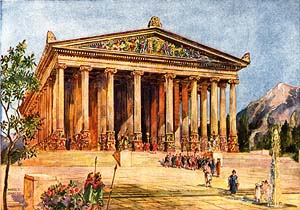
FROM ANTIOCH TO EPHESUS.
JUST how long Paul tarried with the church at Antioch we do not know; but there seem to be good reasons for thinking it was longer than at Jerusalem. Jerusalem was the metropolis of the Jewish nation, and therefore the center of interest to the Jewish Christians; but Paul was preeminently the apostle of the Gentiles, and it is reasonable to believe that he would feel greater responsibility in regard to affairs at Antioch, the metropolis of the Gentile church, than at Jerusalem.
We can well imagine with what joy he was welcomed there, and that he spent a very busy time in settling difficulties and questions which had arisen in the Antioch church, and that he left them with many exhortations to continue steadfast in the faith.
It is distinctly stated in Acts that he "passed through the upper coasts" before returning to Ephesus, in accordance with the promise he had made the brethren there on his former hasty visit.
By this we understand that he did not make the journey by water, but probably passed over very much the same route as on his former journey from Antioch, -through the regions of Cilicia and Lycaonia, Phrygia and Galatia.
This would give him a chance again to visit Tarsus, the home of his youth, and the churches, which he had raised up through those parts, -Derbe, Lystra, Iconium, Antioch in Pisidia, etc. Ephesus was so long the scene of the apostle's labors that we cannot but feel interested in some description of it.
It was beautifully situated on some rocky hills in the broad and level valley of the Cayster River, and yet was near to the sea, of which it commanded a fine view.
The city was in the days of the apostle the greatest city of Asia Minor and the metropolis of the province of Asia.
Being visited by ships from all parts of the Mediterranean, and united by roads with all the large towns of the interior, it was the meeting place of various characters and classes of men.
This made it, like Corinth, a fitting place for the apostle to direct his labors from.
Those who now walk over the desolate site of the once proud city, see piles of ruined edifices on the sides of the rocky hills whereon it was builded.
They look from Mount Prion, the highest of these hills, out over the morass, which was once the fine harbor of Ephesus, where Aquila and Priscilla landed.
In the bowels of the same hill they visit the rich marble quarries, now unentered save by travelers and wild beasts, and see where was obtained the beautiful marble, which made the great buildings of Ephesus.
They trace the enclosure of the stadium, which doubtless suggested to Paul many of the figures used in his epistles.
And not of least interest are the ruins of the vast theater, where the multitude, aroused by Demetrius, the silversmith, cried out for two hours in honor of their heathen goddess. These are only a few of the splendid ruins, which go to show what Ephesus was.
But one building in Ephesus surpassed all the rest in magnificence and fame.
This was the temple of Diana, which glittered in brilliant beauty at the head of the harbor, and was reckoned by the ancients as one of the wonders of the world.
It was said that the sun in all his course looked on nothing more magnificent than this great heathen temple.
It was a very ancient building, and was many years in erection.
The laying of its foundations and the beginning of its structure are lost in the mists of time.
At last it was completed.
But the building, which rose through the space of so many years did not long remain in the beauty of its perfection.
On the very night in which
Alexander the Great was born, it was burned to the ground. Yet in the process of time the temple was rebuilt with more magnificence than before. The ladies of Ephesus even contributed their jewels to help on the work.
The national pride in this heathen sanctuary was so great that when Alexander offered great sums of money toward its erection, if he might but inscribe his name on the building, he was refused.
The building was four hundred and twenty-five feet in length and two hundred and twenty in breadth, and the columns were sixty feet high.
The number of columns was one hundred and twenty-seven, each the gift of a king. Some of them were of marble and others of rare stones. The folding doors were of cypress wood, the part, which was not left open to the sky, was roofed over with cedar wood, and the stair_ case was formed of the wood of one single vine from the island of Cyprus.
Probably no religious building in the world was ever the center of a greater amount of admiration, enthusiasm, and superstition.
But the glory of the Ephesians lies low jasper; its remains may be found in the columns of green, which support the dome of the cathedral of St. Sophia, at Constantinople, and in the naves of other European cathedrals.
E. B. G.